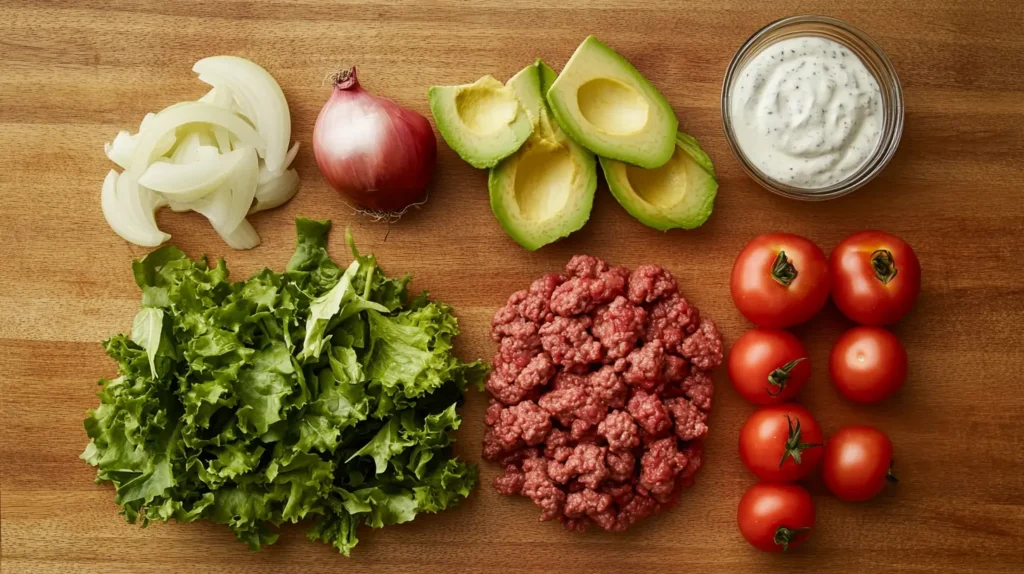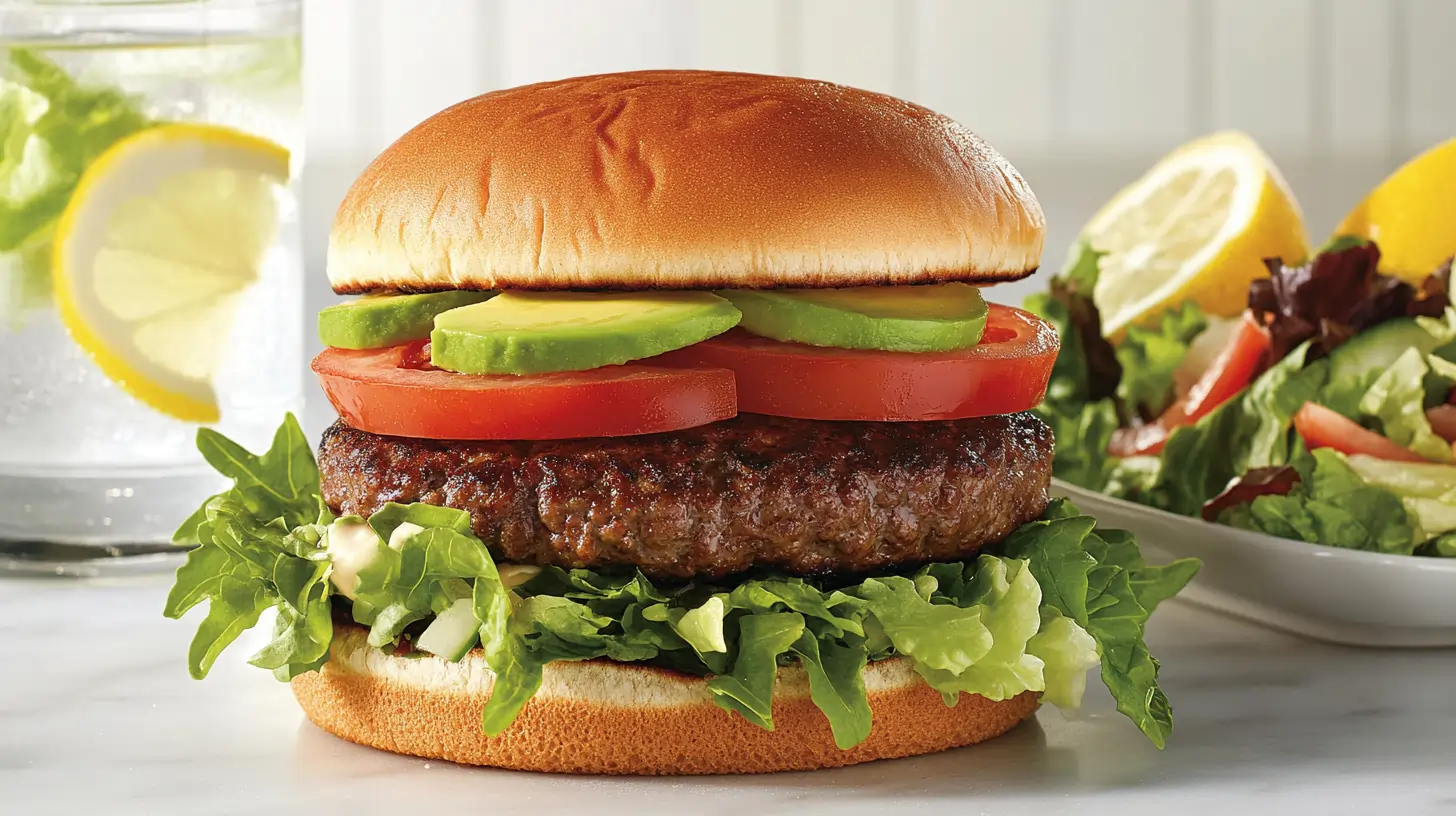Introduction to Healthier Hamburgers
Hamburgers are a favorite meal for many people, loved for their tasty and satisfying nature. However, they often have a reputation for being unhealthy. What is the healthiest way to eat a hamburger? This guide shows how you can make hamburgers healthier without losing their great flavor.
Why Hamburgers Have a Bad Reputation
Hamburgers often get a bad name because of their links to fast food and unhealthy eating habits. For example, here are some common concerns:
Ditch Dinner Stress — Cook Smart, Not Hard 🍽️
35 quick & budget-friendly 5-ingredient dinners to save your evenings. Simple. Delicious. Ready in 30 minutes or less.
- Too Many Calories: Traditional burgers are often high in calories, thanks to fatty meat, large portions, and rich toppings like cheese and creamy sauces.
- Unhealthy Ingredients: Many burgers use white bread, processed meats, and other ingredients that lack nutrition.
- Not Balanced: Burgers often miss key nutrients like vegetables and lean proteins, and are high in fats and simple carbs.
- Large Portions: Supersized burgers and sides like fries and sugary drinks can lead to overeating.
Balancing Flavor and Nutrition in a Hamburger
Making a burger healthier doesn’t mean it has to taste bland. In fact, small changes can make a big difference. Here’s how:
- Choose Lean Protein: Use leaner meats like turkey or chicken. Alternatively, you can try plant-based options like beans, lentils, or tofu. If you prefer beef, go for lean cuts.
- Use Whole Grain Buns: Replace white buns with whole grain ones for more fiber and nutrients. If you want to cut carbs, you can also use lettuce leaves or mushrooms as low-carb options.
- Add More Vegetables: Include fresh vegetables like lettuce, tomatoes, onions, and cucumbers. Additionally, roasted veggies like peppers can add extra flavor.
- Pick Healthier Sauces: Skip heavy sauces like mayo. Instead, try lighter options like mustard, hummus, or yogurt-based spreads.
- Keep Portions Smaller: Avoid oversized burgers and serve them with healthy sides like salads or roasted veggies rather than fries.
- Cook Smart: Grill, bake, or air-fry your burger patties instead of frying them in oil to cut down on fat.
Choosing the Right Ingredients

What is the healthiest way to eat a hamburger? It starts with choosing smarter ingredients. Each part of the burger—patty, bun, toppings, and condiments—can be optimized to enhance nutrition without sacrificing flavor. Let’s explore how to make a healthier burger step by step.
Healthiest Meats for a Burger Patty
The burger patty is the heart of any hamburger, and choosing the right protein source is key to making a nutritious choice. If you’re wondering how to make a hamburger healthier, consider these options:
Lean Ground Beef vs. Turkey vs. Plant-Based Alternatives
- Lean Ground Beef:
Opt for beef with 90% or more lean content to reduce fat and calories. Grass-fed beef is an excellent choice because it contains more omega-3 fatty acids and fewer saturated fats, making it a better option for a healthy hamburger. - Turkey:
Ground turkey, especially breast meat, is lower in fat and calories than most ground beef. This is ideal for those asking, “What’s the healthiest meat for a hamburger?” - Plant-Based Alternatives:
Black beans, lentils, tofu, or chickpeas are nutrient-packed options that are high in fiber and protein. Pre-made plant-based patties are convenient, but check the labels for sodium and preservatives to ensure they align with your goal of making a healthier hamburger.
Healthier Buns or Alternatives
If you’re trying to discover the healthiest way to eat a hamburger, rethink the bun. Many traditional buns are high in refined carbs and offer little nutritional value. Opt for these alternatives:
Whole-Grain, Gluten-Free, or Lettuce Wraps
- Whole-Grain Buns:
These provide more fiber, vitamins, and minerals compared to white bread. Look for buns with minimal added sugar or preservatives. - Gluten-Free Buns:
Ideal for those with gluten sensitivities, these can be made with nutrient-rich flours like almond or quinoa flour to keep your burger healthy. - Lettuce Wraps:
A low-carb and refreshing alternative to traditional buns, lettuce wraps are perfect for anyone seeking a lighter way to enjoy their hamburger.
Nutrient-Dense Toppings
Choosing nutrient-rich toppings is another step toward figuring out what is the healthiest way to eat a hamburger. Focus on fresh, wholesome options while avoiding calorie-laden extras.
Adding Vegetables: Lettuce, Tomatoes, Onions, and Avocado
- Lettuce: Adds crunch and hydration with minimal calories.
- Tomatoes: Packed with vitamin C and antioxidants like lycopene.
- Onions: Provide a savory flavor and beneficial compounds like quercetin.
- Avocado: A source of healthy fats that promote satiety and enhance the overall flavor of your burger.
Skipping High-Calorie Toppings like Bacon and Excess Cheese
- Avoiding Bacon: Bacon is high in saturated fat and sodium, which can detract from your goal of a healthier hamburger.
- Limiting Cheese: Use reduced-fat cheese or skip it entirely to reduce unnecessary calories and fat.
Choosing Low-Calorie Sauces and Condiments
The sauces and condiments you choose can greatly impact how healthy your hamburger is. Opt for lighter, flavorful options instead of heavy, calorie-laden choices.
Mustard, Yogurt-Based Sauces, or Light Mayonnaise
- Mustard: A bold, low-calorie option. Dijon or whole-grain mustard can add a gourmet touch without adding unnecessary calories.
- Yogurt-Based Sauces: Combine plain Greek yogurt with herbs, garlic, or lemon juice for a creamy, healthy alternative.
- Light Mayonnaise: Use sparingly or choose reduced-fat versions to cut calories while keeping the classic taste of your hamburger.
Cooking Techniques for a Healthier Burger

The way you cook your burger can make a big difference in its nutritional profile. Adopting healthier cooking methods helps reduce fat and calorie content while retaining flavor and texture.
Grilling vs. Pan-Frying: Which Is Better?
Grilling
- Advantages:
- Grilling allows excess fat to drip away from the patty, reducing overall fat content.
- It adds a smoky flavor without the need for additional oils or fats.
- Ideal for outdoor cooking and large batches.
- Tips: Use a medium heat to avoid charring, which can produce harmful compounds.
Pan-Frying
- Advantages:
- Pan-frying offers better control over cooking temperature and can produce a caramelized crust.
- Works well for smaller patties or when grilling isn’t an option.
- Healthier Alternative: Use a non-stick or cast-iron pan and skip the added butter or oil. Instead, cook with a light spray of olive oil or use broth to prevent sticking.
Avoiding Extra Fats During Cooking
- Trim Visible Fat: If using meat with higher fat content, trim visible fat from ground beef or other cuts.
- Skip the Butter: Avoid cooking patties in butter or heavy oils. Instead, use healthier options like a non-stick pan or grill mat.
- Drain Excess Fat: After cooking, place patties on a paper towel to absorb any extra grease.
- Choose Low-Fat Marinades: If marinating your patty, use citrus juices, herbs, or spices instead of oil-heavy mixtures.
Portion Control and Serving Size
Portion control is key to enjoying a healthier hamburger. Overly large patties or heavy sides can turn a nutritious meal into a calorie overload. Here’s how to strike the right balance.
Keeping Patties Moderate in Size
- Stick to 4-6 Ounces: A patty this size is satisfying while keeping calorie and fat intake in check.
- Flatten Evenly: Form your patties to an even thickness to ensure thorough and even cooking without the need for excessive size.
- Use a Scale: Measuring your portions helps maintain consistency and avoid oversized patties.
Building a Balanced Plate Around the Hamburger
- Healthy Sides:
- Replace fries with roasted sweet potatoes, a side salad, or grilled vegetables.
- Whole-grain pasta salad or quinoa can add fiber and nutrients.
- Avoid Sugary Drinks:
- Pair your burger with water, iced tea, or sparkling water with a splash of fruit juice.
- Include a Variety of Nutrients:
- Incorporate greens, healthy carbs, and proteins into your plate for a balanced meal.
- Think of your burger as one component of the plate, not the entire meal.
Healthier Side Dish Pairings
What is the healthiest way to eat a hamburger? It’s not just about the burger itself—your choice of side dishes can elevate its nutritional value and create a well-rounded meal. By opting for wholesome sides and avoiding high-calorie extras, you can enjoy a burger that’s both satisfying and healthy.
Opting for Salads, Roasted Veggies, or Baked Fries
- Salads: Pair your hamburger with a fresh, nutrient-packed salad. Greens like spinach, arugula, or kale add vitamins and fiber, while colorful vegetables such as cucumbers, cherry tomatoes, and bell peppers enhance flavor. To keep your salad in line with a healthy hamburger meal, use light vinaigrettes or lemon juice instead of heavy dressings.
- Roasted Vegetables: Roasted vegetables, like sweet potatoes, zucchini, carrots, and asparagus, are a nutritious side. Lightly coat them with olive oil and herbs for a flavorful complement to your healthy burger.
- Baked Fries: Swap traditional deep-fried options for baked fries made from sweet or regular potatoes. This simple switch aligns with the goal of eating hamburgers more healthily.
Avoiding Sugary Beverages and Choosing Water or Tea
- Water: Staying hydrated is an essential part of any meal, including a hamburger. Water is calorie-free and refreshing, making it a perfect pairing.
- Unsweetened Iced Tea: For a flavorful alternative to sugary sodas, try iced tea. Herbal or green tea options provide antioxidants without added sugar, enhancing the healthiness of your meal.
- Sparkling Water: If you crave carbonation, opt for sparkling water with a splash of natural fruit juice. It’s a healthier choice when aiming to eat a hamburger in the healthiest way possible.
Nutritional Considerations of Hamburgers
Understanding what is the healthiest way to eat a hamburger involves breaking down its nutritional components. By swapping certain ingredients and adjusting macronutrients to fit your dietary goals, you can enjoy a healthier version of this classic dish.
Calorie Breakdown of a Standard vs. Healthy Hamburger
The calorie content of a hamburger depends heavily on its ingredients. Here’s a comparison:
- Standard Hamburger:
- Beef patty (80/20): ~280 calories
- White bun: ~140 calories
- Cheese: ~100 calories
- Sauces (mayo, ketchup): ~90 calories
- Total: ~610 calories (without fries or a drink)
- Healthy Hamburger:
- Lean beef or turkey patty: ~200 calories
- Whole-grain bun or lettuce wrap: ~100 calories
- Fresh vegetables (lettuce, tomato, onion): ~20 calories
- Light sauce (mustard, yogurt-based): ~30 calories
- Total: ~350 calories
By swapping out high-calorie options for leaner, nutrient-rich ingredients, you can cut calories by nearly half while still enjoying a flavorful hamburger.
Adjusting Macronutrients for Dietary Goals (Keto, Low-Carb, etc.)
- Keto Diet: For those asking, “What is the healthiest way to eat a hamburger on keto?”, focus on high-fat, low-carb options. Use a lettuce wrap, add avocado, and choose high-fat sauces like mayo.
- Low-Carb Diet: A low-carb hamburger can be achieved by using a low-carb bun or lettuce wrap and focusing on lean proteins and fresh veggies.
- High-Protein Diet: For those seeking protein-packed meals, double up on lean patties or add a fried egg.
- Low-Fat Diet: Choose lean proteins like turkey or plant-based patties. Use minimal cheese and sauces, and pile on fresh vegetables to add flavor and volume.
Tips for Dining Out and Ordering Healthier Hamburgers
Dining out doesn’t mean you have to give up on eating a hamburger the healthiest way. With a few smart strategies, you can enjoy a nutritious meal even at a restaurant.
Customizing Burgers at Restaurants
- Request Modifications: Ask for leaner meats like turkey or grilled chicken patties. Choosing a whole-grain bun or a lettuce wrap aligns with your goal of eating a healthier hamburger.
- Choose Toppings Wisely: Skip calorie-dense options like bacon or fried onions. Instead, load up on nutrient-rich additions like avocado, lettuce, and tomatoes.
- Control Sauces: Request sauces on the side to manage portions. Opt for mustard or light vinaigrettes instead of mayo.
Avoiding Hidden Calories in Fast Food Options
- Beware of Combo Deals: Fast food often pairs burgers with fries and sugary drinks. Skip the combo and opt for water or tea to keep your meal aligned with healthier eating.
- Study the Menu: Look for options labeled “grilled” or “low-calorie” to find the healthiest hamburgers.
- Skip the Extras: Avoid high-calorie add-ons like loaded fries or milkshakes. These extras can quickly derail your goal of eating hamburgers healthily.
Common Mistakes When Trying to Make Healthy Hamburgers
Even with the best intentions, some common pitfalls can undermine efforts to make a healthier burger. Avoid these mistakes to ensure your burger stays nutritious.
Overloading on “Healthy” Toppings
While toppings like avocado, nuts, or hummus are nutritious, they are also calorie-dense. Adding too much can significantly increase the calorie count of your burger. Stick to moderate portions and balance them with lower-calorie vegetables like lettuce, tomatoes, or cucumbers to maintain a healthy balance.
Ignoring Cooking Methods that Add Extra Fat
The way you cook your burger can make or break its healthiness. Pan-frying in oil or butter adds unnecessary fat and calories. Instead, grill, bake, or air-fry your patty to achieve the same great flavor without the extra grease.
FAQs About Eating Hamburgers Healthily
Can I Eat Burgers on a Weight Loss Diet?
Yes, you can enjoy burgers on a weight loss diet by making mindful choices. Use lean proteins, skip calorie-heavy buns, and opt for lighter toppings and sauces. Pair your burger with healthy sides like salads or roasted vegetables and stick to moderate portion sizes to stay on track.
What Are the Best Meat Alternatives for a Healthy Burger?
Some excellent meat alternatives include:
- Black Bean Patties: High in fiber and protein, black beans are a satisfying, plant-based option.
- Lentil Burgers: Packed with nutrients, lentils are low in fat and rich in iron and folate.
- Tofu or Tempeh Patties: These soy-based options are great sources of plant protein.
- Mushroom Burgers: Portobello mushrooms make a juicy, flavorful patty with minimal calories.
These alternatives provide a variety of textures and flavors, catering to different dietary needs.
Closing Thoughts
Why Healthy Hamburgers Are Achievable and Delicious
Transforming a classic hamburger into a healthier meal is not as difficult as it may seem. By making small adjustments to ingredients, cooking methods, and portion sizes, you can enjoy a burger that’s both nutritious and flavorful. For example, choosing the best types of meat for crafting a healthy burger can make a significant difference. You can learn more about this in this comprehensive guide. Additionally, consider exploring creative ideas like a burger bowl as a low-carb alternative to the traditional hamburger by checking out this recipe. Whether you’re preparing one at home or ordering out, healthier choices are always within reach.
Encouragement to Try Making Healthier Choices
Creating healthier hamburgers is an opportunity to experiment with fresh ingredients and new flavors. Start small by swapping just one or two components, such as using juicy burger patty secrets for perfection, which you can explore in this article. Remember, healthy eating doesn’t mean giving up on the foods you love—it’s about finding a balance that works for your lifestyle. If you’re looking for inspiration, check out some customizable burger bowl recipes to kickstart your healthier journey by visiting this resource. So, give it a try and savor the taste of a healthier hamburger.
